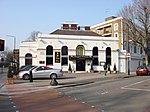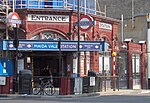St Mark's, Hamilton Terrace
Church of England church buildings in the City of WestminsterGrade II* listed churches in the City of WestminsterLondon church stubsMaida ValeUnited Kingdom listed building stubs

St Mark's Church, Hamilton Terrace, is an Anglican church in the St John's Wood neighbourhood of London, located at the intersection of Abercorn Place and Hamilton Terrace. Dating to 1846–1847, it was designed by Thomas Cundy with a spire built by his son in 1864, and is Grade II* listed with Historic England.The church contains an excellent collection of mosaics by Salviati.
Excerpt from the Wikipedia article St Mark's, Hamilton Terrace (License: CC BY-SA 3.0, Authors, Images).St Mark's, Hamilton Terrace
Abercorn Place, City of Westminster St. John's Wood
Geographical coordinates (GPS) Address External links Nearby Places Show on map
Geographical coordinates (GPS)
| Latitude | Longitude |
|---|---|
| N 51.53213 ° | E -0.1823 ° |
Address
Saint Mark's Church
Abercorn Place
NW8 9XU City of Westminster, St. John's Wood
England, United Kingdom
Open on Google Maps










